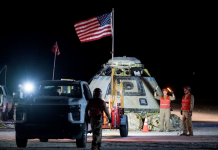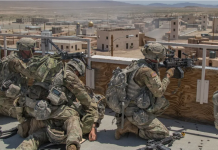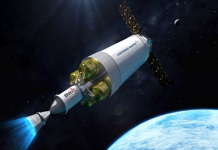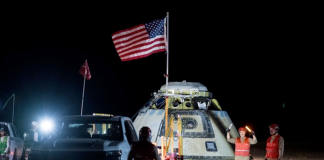By Joshua C. Huminski
This December, the Space Force celebrates its fifth birthday. For some, this will come as a surprise. Has it really been five years already? For others, there will surely be questions as to what the Space Force has done in those five years. For others yet still, there will be questions as to what the Space Force is or does.
It would be rather easy to simply focus on the service’s public relations challenges — forever obligated, it seems, to explain the “why” of its existence as opposed to the “how” or “what” the service does. The reality is rather different — and far more impressive than most would suspect or appreciate.
After five years, the Space Force is a clear success, if an underappreciated one. It is responding to a dynamic geopolitical and geostrategic environment, adapting to an increasingly competitive commercial environment and working to better integrate space capabilities and awareness across all services. The service does face significant challenges ahead both in terms of adversary capabilities and strategic evolution on orbit and in terms of continuing to reform outdated bureaucratic and acquisition systems, but the progress is undeniable — this is simply not Air Force Space 2.0, but a service designed for and responding to this new era of strategic competition.
Up front, it is important to acknowledge the simple truth: the Space Force is responsible for the largest area of responsibility — the entirety of space — with the smallest budget and the smallest service size of any branch of the military. It is attempting to modernize existing and legacy assets, ensuring, for example, the delivery of nuclear-hardened communications while seizing on next-generation and future technologies like proliferated architectures. It is working with combatant commands to deliver new space capabilities while educating those commands on what space can do for their operations. As far as to-do lists go, it is rather long, rather challenging and rather significant.
At a purely structural and bureaucratic design level, the Space Force’s development and maturation reflects just how much the environment shapes institutions. It is the first service to build itself amid a changing strategic environment, aligning its capabilities against near-peer competitors in Russia and China. It is also building itself in a radically new commercial space environment, one where the private sector’s innovation is outpacing the government’s ability to conceptualize new capabilities, let alone integrate them into the national security space arsenal.
The service has opened the conversation about national security space like never before — having open and transparent conversations about space-based threats from adversaries like Russia and China. At the end of October, General B. Chance Saltzman, the Chief of Space Operations candidly said that China is fielding new space capabilities at a “mind-boggling” pace. The Space Force is, simultaneously, shaping the strategic conversation by increasingly disclosing information about American capabilities, such as the X-37B spaceplane’s orbital maneuver, which is emblematic of this forward-leaning approach.
This serves two invaluable functions. First, it raises the level and quality of the discussion about space security and superiority within the Department of Defense and Congress, but also within the American public. This engenders a sense of urgency to the conversation that was once the exclusive reserve of those with relevant clearances. Second, it sends a signal to America’s adversaries that Washington sees what they are doing on orbit and that the country is not without countermeasures or responses.
The Space Force has also moved with great alacrity to grow and enhance the spectrum of its commercial and international partnerships. The Space Force works closely with newly emerging companies as well as legacy primes to acquire and field new capabilities, crafting a Commercial Space Strategy. This approach is both by consequence and by design. In the event of a conflict with China, a distinction between military and commercial space assets by Beijing is unlikely — indeed as Starlink has demonstrated most recently and most vividly in Ukraine, commercial assets are critical enablers to modern combat operations.
This close partnership is also needed to offset the budgetary limitations the Space Force encounters — it is about maximizing the bang received for the buck. The Space Force’s forward-leaning approach on phase three of the National Security Space Launch (NSSL) program, is emblematic of the cultural change and the recognition that the commercial space sector has — pardon the pun — taken off, opening new opportunities for the service and American military writ large. The NSSL program, which succeeds the Evolved Expendable Launch Vehicle program in recognition of the increasing competitiveness of the commercial launch market, now provides the government with two lanes for launch based on risk and mission profile.
Internationally, the Space Force works closer than ever with America’s closest allies and partners in the Five Eyes intelligence sharing network as well as other allies in Europe and the Indo-Pacific. This includes information-sharing, joint acquisition and burden-sharing. The Space Force is stitching together a complex web of relationships and partnerships that will enhance our collective defense posture on orbit.
These successes in no way diminish the scale of the challenge ahead. Building a new service culture while simultaneously changing the legacy and inheritance of Air Force space remains challenging. While there has been considerable progress in moving faster in acquisition, it has not permeated fully through the entirety of the system. Comparable programs are often managed under different acquisition oversight frameworks, which at times seem arbitrary and capricious. Programs often move not at the speed of innovation but the speed of paperwork and bureaucracy. The decisions of program managers and contracts officers, too wedded to the peacetime approach to acquisition are creating additive friction — friction that delays the delivery of capabilities to the warfighter.
The most pressing and urgent challenge remains the main pacing threat — China. The Space Force must outpace Beijing in developing and fielding new capabilities, all while meeting its existing obligations amidst a turbulent political and budgetary environment. Permeating the changes initiated by the first Chief of Space Operations, General John Raymond and now executed by General B. Chance Saltzman and Vice Chief of Space Operations, General Michael Guetlein, will take time, but the service recognizes the urgency and is moving forward.
The challenges of strategic competition with China on orbit are significant, but it is equally important to reflect on the progress the Space Force has made in a short period of time and give credit where credit is due, especially on its fifth birthday.
Joshua Huminski is the Senior Vice President for National Security & Intelligence Programs and Director of the Mike Rogers Center at the Center for the Study of the Presidency & Congress, where he runs the National Security Space Program.













